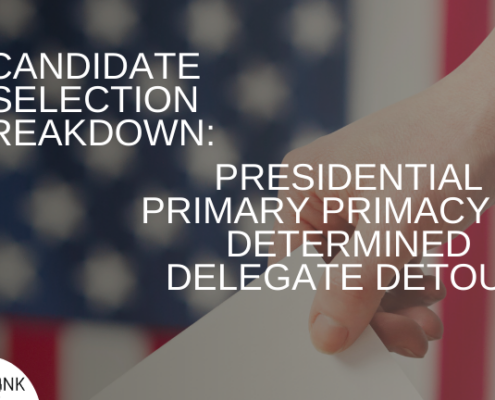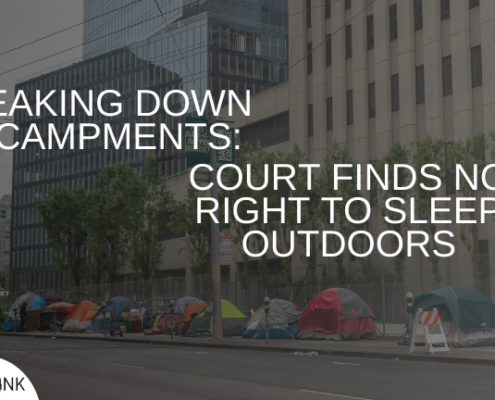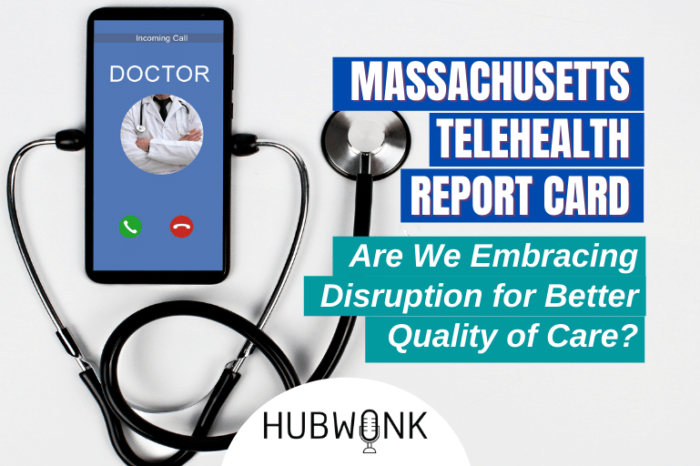Massachusetts Telehealth Report Card: Are We Embracing Disruption for Better Quality of Care?
/in COVID Health, COVID Podcasts, Featured, Healthcare, News, Podcast Hubwonk /by Editorial Staff
Hubwonk host Joe Selvaggi talks with Pioneer Senior Fellow in Healthcare Josh Archambault about his newest research paper, produced with the Cicero Institute and the Reason Foundation, on states’ success in implementing telehealth to improve healthcare outcomes. They discuss how Massachusetts has used remote medicine to better reach patients and serve their needs.
Read the report here: https://bit.ly/50StateTelehealth.
Guest:
 Josh Archambault is President and Founder of Presidents Lane Consulting. He is a Senior Fellow at both Pioneer Institute and the Cicero Institute. His work experience has ranged from work as a Senior Legislative Aide to a governor, Legislative Director for a state senator, to years working for think tanks operating in thirty-five states, and in D.C. He is a regular contributor to the influential Forbes.com blog, The Apothecary. Josh holds a master’s in public policy from Harvard University’s Kennedy School of Government and a B.A. in political studies and economics from Gordon College.
Josh Archambault is President and Founder of Presidents Lane Consulting. He is a Senior Fellow at both Pioneer Institute and the Cicero Institute. His work experience has ranged from work as a Senior Legislative Aide to a governor, Legislative Director for a state senator, to years working for think tanks operating in thirty-five states, and in D.C. He is a regular contributor to the influential Forbes.com blog, The Apothecary. Josh holds a master’s in public policy from Harvard University’s Kennedy School of Government and a B.A. in political studies and economics from Gordon College.
Get new episodes of Hubwonk in your inbox!
WATCH:
Read a Transcript of This Episode
Please excuse typos.
Joe Selvaggi:
This is Hubwonk. I’m Joe Selvaggi.
Joe Selvaggi:
Welcome to Hubwonk a podcast of Pioneer Institute, a think tank in Boston. The strain to our healthcare system created by the COVID 19 pandemic has given rise to innovations that will forever change the face of medicine, perhaps chief among these is the embrace of telehealth. The ability to access healthcare remotely telehealth smokes, obvious benefit is that it can facilitate a connection between patient and provider in a convenient and less costly setting, but an overlooked if perhaps is the promise of improving patient care itself, by offering more targeted and coordinated expertise while providing health data from tests performed at home. Imagine the benefit to a diabetic patient with mobility issues of having remote access to a diabetes specialist and nutritionist, and being able to provide real time medical data to those providers from home for populations like these telehealth can be a lifesaver. How well has Massachusetts done to ensure this technology is integrated into our system and how can we improve in the future?
Joe Selvaggi:
My guest today is Pioneer Institute’s senior fellow in healthcare. Josh Archambault. In a new paper produced by Pioneer Institute in coordination with the Cicero Institute and the Reason Foundation entitled “Rating the states on telehealth practices, a toolkit for pro patient and provider landscape.” The researchers offer an outline of best state level policy practices in telehealth and creates a report card of success for each state. Josh will share with us which criteria are vital for optimizing the benefits of telehealth and how well has Massachusetts scored in his analysis. When I return, I’ll be joined by Pioneer Institute’s Josh Archambault.
Joe Selvaggi:
Okay. We’re back. This is Hubwonk. I’m Joe Selvaggi, and I’m now joined by Pioneer Institute’s Senior Fellow on healthcare, Josh Archambault. Welcome back to Hubwonk, Josh.
Josh Archambault:
I always enjoy being on. Thanks, Joe.
Joe Selvaggi:
Well Josh, you, you have been on the show before and we’ve talked about telehealth in the past. You’ve you’ve, you’ve sung the praises of the benefits of telehealth, but largely in the beginning when you were first on, we were at the early phases of the pandemic and folks were terrified. They didn’t wanna risk getting sick by going into a hospital to see their, their doctors. So a lot of these telehealth measures were emergency procedures that we did at a desperation. And the unknown. Now we’re getting to a phase of the pandemic. It’s been with us almost two years and we wanna see what parts of telehealth makes sense going forward into the future.
Joe Selvaggi:
So you’re recently released pioneer paper entitled rating the states on telehealth practices, a toolkit for pro patient and provider landscape. You’ve offered a scorecard for state level policymakers to say, okay, how well are we embracing this technology called telehealth? So for the benefit of our listeners who may not have heard earlier conversations about telehealth, let’s start at the beginning and say, okay telehealth, it’s, it’s a good thing. We’re talking about communicating with our healthcare provider or with our hospital, the way you and I are communicating right now, virtually let’s talk about what this complimentary technology, how does it help a patient and a provider?
Josh Archambault:
Yeah. So as you mentioned, I mean, I think COVID brought telehealth not only into our headlines, but into many of our bedrooms into our dining rooms, into our living rooms, wherever many of us have done telehealth visits. And I think it’s really exciting about where we are right now is we are in this assessment phase where a lot of people have tried telehealth for the first time, including providers who were, many of them were reluctant pre COVID to use telehealth as a tool in their toolbox. There’s certainly been a lot of investors pouring money into digital health care and telehealth space. And I think also there’s two kind of tracks conversations happening right now, which are really interesting to me. One is on the policy side and that’s where the paper certainly looks at looking at these eight best practices, trying to understand what policy landscape do we need to have that allows for the most innovation to emerge that is probation and pro provider.
Josh Archambault:
But the secondary part of that is what is the best use to telehealth? The policy environment can be flexible or maybe restrictive, but ultimately providers and patients need to decide how do they wanna use telehealth? It are there ways in which in person visits are a hundred percent going to be the way to meet people going forward and get certain kinds of care. And in what instances is telehealth act you the most helpful? I think what’s interesting. And I think what the general public doesn’t fully still appreciate about telehealth is they think about what we’re doing sitting in front of a computer, on a smartphone video, chatting with somebody, but telehealth is actually much, much broader than that. So, and the report touches on this, looking at things like remote patient monitoring. This means you have something in your home that is maybe in real time, I’ll give you an example.
Josh Archambault:
Somebody with diabetes might be taking their blood sugar level on a regular basis and transmitting that information to their PA to their provider so that their provider has a much better sense of how compliant they are with whatever regimen they have given them, their drugs or other things. What’s interesting about this is that the providers now have not only when there’s a red flag can follow up with you much more quickly, but when they actually see you in person, they may have at their fingertips far more information about how you’re doing health wise than just seeing you once a year or every six months, whatever the condition you may be seeing them to. So the real promise and the potential increase in quality of care over telehealth is making sure that we’ve got all of this data, that’s at your fingertips, but that people aren’t overwhelmed by it, that it actually improves the quality of care. And that’s the kind of tipping point or middle ground that we are right now where people are really trying to assess as we come out of the pandemic. What adds the most value. And, and where is it? Was it just a necessity because of COVID
Joe Selvaggi:
I was struck by your the subtitle of your piece characterizing it as both pro patient and pro provider. We’re talking about the doctors and the hospitals at a high level before we dive into any details. There’s a lot of stakeholders involved here with telehealth. Is there any tension amongst stakeholders? Is it, is, is this great for patients and great for doctors and great for healthcare systems or, or is it some sort of a zero sum game here?
Josh Archambault:
You know, I, I, I don’t think anybody views it as a zero sum game anymore, perhaps pre pandemic that would’ve been the default for some, they were worried about competition or, you know, ways for this to take away business. I, I think people are seeing it as a compliment. There are still areas of disagreement, you know, payment rates, reimbursement rates certainly remain a sticking point of how much should be paid for services, telehealth services. And that’s covered a little bit in the report should be covered at the level that an in person office visit is for just a quick video chat or should it be paid at a different rate. And then who can use telehealth, there’s going to continue to be disagreements within the medical community on whether or just doctors should be able to use it, or whether any provider should be able to use it should a nutritionist, should a physical therapist be able to use it.
Josh Archambault:
And I think that there is largely emerging agreement outside of perhaps dentistry, which seems to be an outlier in this discussion, that telehealth is a helpful tool in the toolbox. And I think as long as acknowledge that it is just that it’s not a silver bullet, it does, it is not the best way to deliver all kinds of care. Then I think that there has been emerging consensus that it, it, it, it is a good tool and it’s just a matter of making sure that the policy landscape allows for the flexibility going forward to deliver care in really innovative ways.
Joe Selvaggi:
I’m glad you mention it, the, I like the word compliment because it’s in addition to traditional in-person medicine, we’ve had doctors on the show who have said, look I’m, I’m skeptical about telehealth. I catch half of the problems with my patients through laying of hands, right. I, I want to see my patients, they, they come in from, with one symptom and I, I find it a different pro problem. You can’t do that virtually do do, does the community acknowledge this limitation of telehealth?
Josh Archambault:
Yeah, I think by and large that there is, of course it’s gonna depend on the specialty area. You know, certain providers certainly think that in person is, should be the dominant way going forward. And you know what, I trust that it’s a little bit of an art in the science here, but I will say that, you know, with the emergence of artificial intelligence and other things, dermatology is a good example. You know, if you have a provider dermatologist, who’s looking at your skin and has seen a thousand examples of something, but if you’re able to use telehealth in which the AI has access to millions of images to compare what you have on your skin, there is actually an enhancement. There, there could be a value add by using telehealth. And so I think going forward really what it is is again, it’s using both.
Josh Archambault:
So do you use telehealth first to use the access millions of images say, Hey, we actually believe this is a problem. And then send that to a provider, say, you need a hundred percent to go see this provider for an in-person care to have that removed, to have it looked at more closely that that’s the value. I, I think what we, for those of us that have been around studying healthcare spending for a long time, we realize probably half at least of care spending is just wasted spending. And part of that is because the healthcare system is not very good at triaging who actually needs in-person care or not. The default is just to go, I mean let me give you a personal example of this. You know, I’ve had health insurance where they have a nurse hotline and you can call in I’ve called in probably a dozen times or so over the years for kids or things that my wife and I have.
Josh Archambault:
And inevitably every single recommendation is go to the ER to get this checked out, even just to cover themselves from a liability standpoint. And so I think ultimately we need a few more options here where people are able to triage much better to direct people. And this is where some of the savings can come from telehealth is really giving you a gap, a very well-informed technology driven. Now, of course, there’s limitations to that, and we wanna be aware of that. And that’s the learning that we need to be in from a medical side, like really assessing where the technology enhances the kind of care and quality of care that’s being provided and where it may not add as much value. And ultimately, and we cover this in the report. I think that’s policy mandates actually become a problem. If you mandate that insurance companies have to cover all kinds of telehealth, regardless of whether we deem it adds value or not, then we’re running into problems of wasted spending. We wanna really make sure that when we spend an additional healthcare dollar, we’re getting better quality care for the patient every single time. And that includes te health as well as it does in person.
Joe Selvaggi:
Now, this is clearly a disruptive technology. I’m asking you a question it’s not in your paper. I think what an investment slide deck would ask is what’s the addressable market. And when you talk about telehealth and, you know, you look at health, the healthcare system very broadly it, it could, is this just at the fringe of the margins 5% or, you know, you, you, you just characterize a lot of waste in the system. You know, could we potentially save hundreds of billions of dollars in the system? Is it 30% that that could be I dunno if the right word is not lo no longer wasted, but more efficiently deployed. Are we looking at that level of disruption?
Josh Archambault:
Yeah, well, we’re well over 3 trillion a year in healthcare spending. So there’s ample opportunity here to increase efficiency in the quality of care provided. No, I think this gets at the question of cost savings that can come from telehealth. And I think there’s, you know, probably at least a dozen ways that telehealth could deliver cost savings. One is it’s just a much more efficient, effective way to be able to deliver services. You can have a provider from their home office from a different state, being able to see people at 24 7, quite frankly, if somebody’s struggling with addiction and they need help at three 30 in the morning while their provider’s not gonna be available locally to see them in person. So there might be an opportunity to use telehealth, to get them in touch with a provider, right at that moment when they are struggling and they need some extra support or they want to try to get clean in that moment.
Josh Archambault:
So there are those kind of interventions in which telehealth can prevent those individuals from ending up in the ER and costing a lot more money, but there’s all sorts of other ways that I think telehealth can be save money in the long run going forward. You know, I think the future of healthcare, a lot of it for certain chronic conditions and remember 80% of healthcare spending is due to lifestyle choices. So finding more effective ways to help patients live healthier lives is really important. And I think team based care. So again, go back going back to the example of somebody with diabetes, yes, you want their primary care doctor engaged, but you also might want a nutritionist engaged, an endocrinologist engage. And in many communities, those specialists simply don’t exist telehealth for the first time allows you to pull together a team to intervene with the patient and say, what is our plan of attack going forward?
Josh Archambault:
Are we being adherent? How can we help support you more to meet your health goals going forward? And if those sorts of innovations are allowed to merge to emerge and they’re being used in some instances now, but if you don’t mandate that insurance companies have to pay one size fits all way, they, you allow them to pay for team based care, try it to see if it actually leads to better health outcomes. You might actually start to see huge long-term savings by using technology. I think everybody knows this and acknowledges this. It’s just a matter of how do we transition because our current health system, especially for large hospital systems is so real estate intensive. It’s very expensive sustain. And so a lot of those health systems are just focused on how do we increase our revenue to the point where we can support that large, large system.
Josh Archambault:
Ultimately, where we wanna go is to have a health system that is patient focused and allows for providers to be able to provide care in a multiple ways. So maybe they start by seeing you in person. Then they say, Hey, go home, bring this device home, take your readings once a day. So I can see how it’s going. Then maybe once a month we pop on and we video chat to make, look at the data to see how it’s going. And then we’ll determine from there, whether we need a follow up appointment or not, that’s the sort of different ways. And that’s what the report gets at. Does your state laws, are they flexible enough to allow for that health system to start to emerge or are there barriers in place? And quite frankly, one of the things we were surprised, Joe doing the report is there’s still a lot of work to do here. There’s a lot of states whose laws have not been updated sufficiently to allow for that, those sorts of health innovations to emerge a lot of states simply tweaked around the edges during the pandemic. And I think there’s a lot more opportunity here and that’s why we put out the report.
Joe Selvaggi:
Wonderful. Well, now let’s get into the, the meat of the report. As you say, it’s, it’s state level focused. We live in a state, more Commonwealth of Massachusetts, there’s 49 other states. So given there’s a difference between Massachusetts and Wyoming, how, how do you compare terms, meaning even the, even the term telehealth may be a vague and defined differently in different states. How did you account for those differences?
Josh Archambault:
Yeah. So there, I think that there’s been a, a growing consensus that there is telehealth. Well, it can be he called and defined slightly differently by states. You’re absolutely right. There are a couple different modalities in which people look for that allows for flexibility. So video synchronous, it’s live, we’re talking back and forth. We’re able to communicate in real time, back and forth, but there’s also asynchronous, which is like, think about texting back and forth with a provider. Maybe you start the relationship over text and then switch over to video if it’s sufficient. But in many instances, allowing for that kind of easy back and forth over text, or for me to record a message and then send it to you later is another kind of form of telehealth. So in the report, that’s what we were looking for. We were looking for state law definition and I give a lot of credit to the American telemedicine association.
Josh Archambault:
Who’s worked really hard with stakeholders to say, how do we come up with definitions that are all encompassing that allow for this flexibility going forward in its, in a state. And a lot of states have started to move in that direction of adopting some of those, the, the looser or broader definitions. Now the, the area where we found the most work to do is not every state allows you to start a patient provider relationship over all of the modalities. Some of them are still prescriptive. You have to do it this way, which I think coming out of COVID, we we’ve come to appreciate and realize that that’s, that’s simply outdated. We should allow for patients again, if we want to really patient centric center system, to be able to establish the relationship in the way that they prefer.
Joe Selvaggi:
So let’s get into the, I think you used eight criterion in your paper. And we’ve touched on some of the issues in each, but I wanna touch each idea discretely. And then I’d like to also, if we can talk about where Massachusetts falls you gave each state a guess a stoplight kind of rating either green, yellow, or red, green being the better and red being not so good. So let’s start at the beginning. You, you just touched on this notion of modality neutral, which is to say I would characterize your piece as saying there’s there’s time in place, right? You have synchronous and asynchronous, meaning I’m interacting live with my provider, but I may not be, as you mentioned and also place meaning I can get a, a blood test in the hospital, but I might be able to have some sort of measurement at a facil either more locally or in my own smartphone or something like this. Right. You, so tell us more, why does it, why is modality neutral so important?
Josh Archambault:
Yeah, I think it, it matters a lot because different kinds of care, demand, different ways of interacting. And, and, and I mentioned the example of somebody struggling with addiction. I mean, whether it’s mental health issues or whether it’s other issues related to addiction there has been consensus in all 50 states that we simply don’t have enough providers, that our system is not set up in a way to be able to meet the demand that’s there. And so we need to make sure that patients, whether it’s somebody that speaks their language, that may not be in their local community, or whether it’s just, I prefer to start by text because I’m feeling ashamed of where I am right now, or just not feeling like I can talk to somebody over a video. We need to make sure that we have that flexibility. And, and I think what’s also important is a lot of the invest investments and entrepreneurs in this space are the thinking really differently about the kinds of tools and ways that patients should interact with providers.
Josh Archambault:
And we just wanna make sure that we have that source of flexibility. I think it what’s encouraging on this one in particular is states are moving in this direction and Massachusetts is one of them, the most recent telehealth bill that passed significantly improved the definite for telehealth in Massachusetts for where it was pre pandemic. And so I do think that there’s, there’s been some great progress here. And, and Joe, maybe let’s just step back for one second and talk about what the report actually is. It’s meant to be a tool kit, and it’s pretty simple, straightforward. It’s four parts to it. The first one is just a brief introduction explaining why action is needed. Second part, what we’re talking about here, the stoplight chart, giving green, yellow, or red rating for all of the states. And then we explain the ratings. That’s the third part. And the fourth part is all 50 states get a page. They all get a profile of where are they on these eight best practices. And so that’s, what’s in the report. It’s meant to be able to for the reader to digest a lot of information, but very simply and very quickly
Joe Selvaggi:
I want to get into where we score relative to the other states. As you say, it’s very comprehensive and it’s, it’s not easy to cover 50 states. So congratulations. So let’s get back to the, the bullet points or the, the features on which you score each state which just talking about Mo modality being important. You alluded to the fact that to really start the ball rolling in telehealth, many systems require the first step to be an in-person requirement. Now that may saying, seem like a no brainer first, see your doctor, and then we’ll talk about virtual. But in many cases, a someone may not live in your doctors or may have some reticence about going to a doctor, say for instance, during a pandemic or, or some other time. So say more about why that in-person requirement may be really harmful to tele health uptake.
Josh Archambault:
Yeah. For, I mean, transportation remains an issue for those with chronic conditions or in rural communities. This is the one measure where we by far saw the most progress during the pandemic. There were a number of states pre COVID that required you to see a provider. First, you had to go have an in-person visit. And on one hand, you understand that you want there to be your relationship, and you want them to have a basic understanding of your health situation. But if you live in a community where there’s a provider, a primary care provider shortage, and you simply can’t get an appointment for three months, which is not that uncommon in many areas, this just seems impractical. And quite frankly, out of date. So a lot of states moved. There’s only a few lingering states that still requires some sort of in-person visit ahead of time. And I think this is again, when you talk to policy makers, the one that they shake their head, why would we have ever required an in-person visit? But that’s just what happens when state states pass laws that have to do with technology that are 10 years old at this point, technology changes. And as a result, when you need to change the policy landscape too.
Joe Selvaggi:
So our, our local legislators seem to get that. I mean, that’s, that’s Massachusetts understands why that might not be or that would be a, a good policy to remove the requirement for in-person visits first. Right?
Josh Archambault:
Correct. Yep. Massachusetts does not require an in-person visit. I think that’s really important. And I would hope with all of the tech companies that are in our backyard, again, we’re not trying to replace all in-person visits, but it just says that if you need to start by telehealth first, then, then you can do so if that’s appropriate
Joe Selvaggi:
Now, this way to be, I’d be curious about, and I can understand perhaps why, what motivates a rule like this, but no barriers to access across state lines. For me again, you and I, we, we believe in markets and we think state lines might be artificial barriers you know, contrived barriers but removing those lines and allowing a, a doctor in Boston to treat someone in, in Nebraska. You know, why, why is that so important to, to telehealth?
Josh Archambault:
Yeah. So the way that I actually think about this is an example outside of telehealth. So think about a pilot. We allow a pilot to take off in one state, then they land in another, and we haven’t assumed they’ve lost all of their skill and knowledge. And then we allow them to take off again. But yet for medical providers, we assume that as soon as they cross the state line, especially in a place like new England, where, you know, in half an hour, 45 minutes, you’re in another state. We just assume that they’re, they’re unqualified to see patients. I, I, I think this one is they’re in the telehealth world. This one is seen as a no brainer. There are still special interest groups or provider groups who are more hesitant on this one. So what we score, what we looked for and what we scored for was looking for a state policy that simply allowed providers who were in good standing in their home state.
Josh Archambault:
These people all go to the same medical schools and take the same tests for the most part. If you’re in good standing in one state, then we’re gonna allow you to have a pathway in our state to register with the relevant board or to pay the fee, whatever the basic requirements are. And you can start to see patients now think about the practical implications of this. I mean, the more you think about examples, the more silly you realize what the barriers and protectionism that we have in place right now is in almost every state. There are very few states that allow what, what we’re describing, think about how many people spend time in warmer climates. And yet we’re saying they cannot stay in touch with their providers back home who have maybe known them for decades. They have to establish a brand new relationship with somebody who does not know them.
Josh Archambault:
It because they cannot do across state lines, picture a doctor or a provider who goes on vacation. They are breaking the law. If they are not able to stay back in touch with their patient, cuz they are they’re in vacation in another state. Think about the numerous industries, pilots, flight, attendants, truck drivers who cross straight state lines all of the time as the nature of their employment. And yet we make it difficult. If not illegal for them to stay in touch with providers who maybe they’ve known for years or decades, this is how kind of impractical and silly it is. You hear people all of the time talking about coordination of care and healthcare and how important it is to save money, to have people stay in touch with their providers. That’s what we’re, we’re talking about here. What we’re trying to put that option on the table.
Josh Archambault:
I, I think the concern here from the provider groups is they want complete control over who is practicing in their state or not. And on one hand I underst in, they wanna keep PA patients safe, but on the other, we have shown that licensing does not lead to, I mean, these people are going to the same schools. If they go to the same medical school and they just land in two different states, somehow we’re assuming there are, have completely different qualifications or outcomes. So there are, there is a politically fee way to do this. I would point to states of Arizona and Florida who have relatively recently passed laws that allow for a registration in the state with a relevant board so that, you know, who’s providing care by telehealth in the state. And you also allow for them to take some sort of regulatory action if there is a complaint against a provider.
Josh Archambault:
And I think that ultimately addresses some of the quote unquote safety concerns that have been used to kill these sorts of reforms in the past, but it’s just really impractical the status quo. And if we wanna make sure that there are enough mental health providers, that there are enough providers, period, I mean the tum tsunami of retirements that are coming for doctors over the next 10 years, we have to think differently about how we deliver healthcare and telehealth. And especially this across state line has to be part of the, the process and the conversation. And I think it’s just a matter of time before states actually start to move on this one. Yeah.
Joe Selvaggi:
This seems like get an odd Relic. I certainly don’t imagine among our listeners that someone where they’d get sick in a different state would be concerned whether the doctor they would visit in the emergency room is qualified to practice medicine, right. It doesn’t have not everybody has to go to, you know, a certain school or go to a certain hospital. I, you know, that’s, that seems obvious, but an important point let’s talk about the, that telehealth in certainly in the emergency phase of the orders, it allowed for telehealth for primary care doctors, but not for other practices you, you mentioned in your paper nutritionist and other fields why would this be, why would we just say, okay primary care perhaps is okay with a telehealth, not all these other specialties.
Josh Archambault:
Good question. I don’t know. I mean, what was interesting during the pandemic is that a lot of governors did offer executive orders allowing for a lot more flexibility that just to return back to the across state line, many, many states allowed for that for the first time through executive order. And guess what this guy didn’t fall. In fact, people really came to appreciate they could access more providers. This is another example in which there was unevenness in when it came to executive orders on who could use telehealth. And when we really dug into this, I, I think what was interesting is pre pandemic. And even in a couple states now only doctors are allowed to use telehealth, which just seems, I mean, the nurse practitioners, physician assistants said, these are the backbones nurses. These are the backbones of our healthcare system. And to say that they can’t use telehealth under any instance just seems shortsighted.
Josh Archambault:
But I think in our report, what we were trying to highlight is in a number of states, they do allow a lot of providers to use telehealth, but what they do is, and this is the details that actually really, or is that they tie it to the currently licensed profess medical professions that are in, you know, whatever title that is in state law and the challenge and, and, and problem with that is that there may be some medical providers who aren’t currently listed in that title. And until they’re added to that title, they’re not allowed to use telehealth. The other thing that it does is that it doesn’t allow for new innovative provider types to emerge quickly. They have to go through the whole legislative process to be added to the title before they can use telehealth. So what we suggest is to follow the best practice, which is in a few states of allowing the definition for who can use the telehealth to just be broad, to just say, you know, we’re not gonna mandate that every, everybody has the insurers have to pay for all of this for all the provider types, but if they want to, if they want to try something different, if they wanna work with a different kind of medical provider, they should be allowed to do so.
Josh Archambault:
And that’s what we are really rating at for that factor.
Joe Selvaggi:
That that’s a great segue to another bullet when we talked about independent practice. Again, this sounds like a no brainer, but the phenomenon of nurse practitioners that they could use telehealth a, they should, of course be added to the list along with doctors. But the, the fact that there’s a requirement now that doctors have to oversee this interaction with nurse practitioners, you, you mentioned earlier, there’s an anticipated shortage of, of doctors. I imagine along with the massive tsunami, the of, of baby boomers retiring and along with that, many of those being doctors who are also retiring we’re gonna need a lot of nurse practitioners, I would imagine shouldn’t this telehealth facilitate that, that transition.
Josh Archambault:
Yeah. And that’s what we were looking at here. I mean, we, we could have looked at any number of different medical professions on whether they’re able to practice independently in the ways that they’ve been and trained to do. And I think there has been growing consensus in Massachusetts just joined this this group of states that have allowed nurse practitioners to practice on their own going forward. And that’s what we were looking at. We wanna make sure that the, again, the system is flexible, that can be patient centric. I mean, the challenge here is there’s a cost element to this and many dates. When you see a nurse practitioner, your insurance company, or you get actually charged a doctor’s rate, which in other professions would actually be illegal for you to do, but in medicine, for some reason, we allow it to happen. But there’s more of a practical reason here, why we think it’s important, nurse practitioners and others, they help extend the healthcare system.
Josh Archambault:
You know, whether it’s in a rural community or whether it’s just in an urban community in which getting a primary care doctor’s appointment can take 50, 60 days or longer, which is not uncommon in the Boston area. We wanna make sure that you can be able to see some of these other primary care providers in a more flexible way that they’re able to set up their own practices if they want to and use telehealth as part of that. And that’s what we were trying to look at as one example for nurse practitioners going forward, because that’s just the reality that we’re facing going forward.
Joe Selvaggi:
Well, that links also to a another point point of your paper, no payment mandate. Now you mentioned just in your earlier response that, that providers are charging the same, whether they, you see a doctor or a nurse, but I think what’s more unsettling is that or a nurse practitioner I’ll say is that whether you visit your doctor in the hospital or you have the meeting virtually again from the setting of maybe even the doctor’s own home you’re, it’s mandated that you be charged the same amount. Now some people would strongly prefer telehealth regardless of cost, but some people might use it as a way to save some money or the system saves some money. The system seems to now to forbid a differential in, in those payments you know, say more about that.
Josh Archambault:
Yeah. So when we looked at this one in particular there’s probably about half and half, half states mandated and half the states don’t, and there’s kind of some practical implications. Let me tell you why supporters advocate for the payment mandate. You know, the primary reason that they do is they say, we need to encourage providers to do use telehealth. So we need to pay them the same rate or it’s the same sort of expertise. So we need to pay them the same rate. I, I think the challenge with that is a, a couple fold is that there are some big unintended consequences of mandating that same payment rate. The first is patients who have a deductible are paying the full cost for it. So you are now mandating that they have to pay an inflated rate for services. And what we have seen is, and there’s been survey data on this over the last few years, at least a third of Americans say that they skip needed care over cost concerns.
Josh Archambault:
So what you have just done is you have pulled the rug out from under those who would’ve used telehealth because it would’ve cost slightly less, but there’s actually longer term ramifications for this. The first is these state mandates only apply to the individual market and the small business market. They don’t apply to large companies. So you have now made an unlevel playing field for small companies who tend to pay some of the highest health insurance premium rates in most states. And you have just made it more expensive for them to deliver healthcare. And then finally, I would just say, going forward, it kills innovation. We still largely pay for healthcare and I for service manner. And for those of us that have been in the health policy community, there’s been a raging debate about trying to change the way we pay for healthcare to more value based or based on outcomes or, or pay on a budget instead of to try to change the incentives going forward for just providing more and more care.
Josh Archambault:
And so I, as a result of forcing the insurance companies to pay this inflated rate, you are gonna double down on cementing the uneven payment rates that go to different providers. And if a provider group comes to an insurance company and says, Hey, I wanna do team based care. I wanna try something different. Hey, I wanna follow up with phone calls on a more regular basis insurance, company’s gonna be hesitant to do it if they’re being forced to pay the same amount for an office visit. I mean, think about a phone call costing the same as a 15, 30 minute, 60 minute in person office visit. That’s just impractical. You’re gonna see a massive spike in spending as a result of that. And so I think that there are some big unintended consequences that I’m hoping that over time policy makers won’t just see as, oh, we gotta pay for this because it’s important. We wanna encourage more of it, but they actually understand what the moving pieces are and that there’s implications for forcing mandates on certain parts of the market that hurts patients, vulnerable patients, those with chronic conditions, those in rural communities, small businesses, and actually try to embrace a more even keeled sensible policy framework going forward.
Joe Selvaggi:
Yeah. So to me, it seems sort of economics 101, you take away the price signals and you really don’t understand preferences of patients and doctors, right? If everything costs the same I don’t care what the product is. You don’t understand which people prefer and you don’t encourage innovation. That’s very important. I think also then this we’re almost repeating ourselves. One of your features was no facility fee. Ironically, whether the doctors calling from an expensive place like mass general or from, you know, some rural setting or his home there’s a mandate that there’s a facility fee paid to a telehealth visit. Say more about that.
Josh Archambault:
Yeah. I think this is where we, when we start to really think about the, for flexibility of telehealth and how it can be delivered, I mean, literally from the home of the provider facility fees have been justified for in-person visits at large hospitals as a way to cross subsidize other activities, whether it’s to help pay for the ER or research and development or other things that the hospital might office offer, excuse me, to patients. But here, we’re talking about somebody sitting in their home office and delivering a telehealth visit where the patient pops up right in front of them. There’s no waiting for the patient. There’s no waiting for the provider. They can in theory, see more patients in a, a shorter period of time. And so I think facility fees, which are largely just this extra fee put on in the end again, when we talk about patients who are foregoing care, because of concerns about costs and are paying largely paying it outta pocket, because they have deductibles, we have to allow for a health system that doesn’t have all this cross cross subsidization, especially when it literally does not make sense and should not apply when somebody is sitting in their home and not in the office building in a tower, in a big hospital system.
Joe Selvaggi:
Well, all good points. We’re coming close to the end of the show. I, I also want to say what I loved about your paper is, and I think it’s come through in our conversation. Not all areas of medicine are equal in the eyes of telehealth. Some are easier to utilize telehealth others perhaps less. So you mentioned in the paper, no coverage mandate. And what you say is you, you have concerns with telehealth and in-person treatment with regard as the same in all practice areas without any supporting data. In other words, there’s no sort of measurement as to when we all uptake telehealth, some are going to double their efficiency and others may, may founder. You mentioned say dentistry, I, I, I wouldn’t want a virtual root canal but, but say more about why it’s so important to measure the efficacy of, of these different measures.
Josh Archambault:
Sure. Yeah. So I think the long term success of telehealth is going to be based on us measuring it and in the policy world and debate, it really shouldn’t be a political fight. It really should be. Do we get better health outcomes? I mean, some of the most promising innovations I’ve seen using telehealth has been in the, those dealing with addiction and recovery. You know, we have a sad situation in America with so many people struggling with opioids and other issues in which we pay lots and lots of money for people to go to inpatient programs repeatedly over and over again. And the outcomes are just their lackluster at best, in many instances. And I’ve seen telehealth models where not only are they able to interact with patients when they’re in their moment of crisis and wanting to get clean, but also able to stay in touch with them and keep them sober far, far long, or, I mean, we’re talking a year, two years beyond them, kind of the initial intervention, which if you were to look at the data for inpatient programs, it can’t even be touched in terms of having people cycle back to the program UN unfortunately.
Josh Archambault:
And so I think we need to make sure that we’re studying this, that we’re looking at data that we’re holding telehealth providers to a high standard of showing their efficacy and the quality of care that they are they’re providing. And I think what we’re going to find is that in some areas, telehealth is truly game changing. Telestroke other areas seems to be that these are telehealth should maybe become the standard for how we interact and provide services. And inevitably, we’re gonna find areas where, you know, we just can’t tell, we can’t tell if there’s added benefit here or maybe the outcomes are worse. And so we need to stop paying it. The coverage mandate falls on insurance companies. And as I mentioned previously says, we don’t care about the outcomes you have to pay for it if it’s so over by telehealth, if it’s otherwise covered by your health plan. And I just think that’s shortsighted, we wanna make sure that insurance companies and employers and even individuals, again, when we interact with the healthcare system, we’re actually getting more value for every dollar. And if we’re mandating it, then you remove that flexibility and you’re putting handcuffs on them, quite frankly, for them to try something different, innovative, and they are gonna have to keep paying for the same procedures or the same services over telehealth that may not be adding value
Joe Selvaggi:
Well that that’s a great way to work. We’re coming close to the end of the show. And you, you, you sort of, it seems a theme is policy makers have to insurance companies have to allow flexibility to to see telehealth embraced effectively and it may be different in different area policy area. So from my last question, I’ll just say we have a lot of policy makers that listen to the show and they’re probably excited by what you said about the promise of telehealth. If, if Massachusetts policy makers are listening to the show, what would you say? Where’s the low hanging fruit here in Massachusetts that we could do better to make telehealth a more essential part of our healthcare system.
Josh Archambault:
I, I, I, it’s interesting that you asked that question, Joe, because if you had interviewed me a year ago, I would have different answers than today. I, you know, I think what is encouraging in Massachusetts in particular is there has been some serious conversation about improving the telehealth landscape, you know, started with the governor, with his executive orders. The legislature followed up by passing a new law, which by my count, at least three of the eight things that we looked at improved to green as a result of that reform. So that, that is very promising, but there is certainly more work to be done here. I think we talked about the no barriers to across Stateline telehealth. I think that’s just a no brainer, especially in new England where so many states are so close to each other. This is actually, if you think about it, a business opportunity for Massachusetts providers, whether they want to be able to travel if they’re mobile or whether it’s, we wanna set the, an example for other states so that if they reciprocate Boston based or Massachusetts based providers can actually see patients from other states a lot more easily.
Josh Archambault:
So there’s work to be done there. We talked about the coverage mandate, unfortunately in the update, they did pass that insurance companies have to cover telehealth services and they did keep a payment mandate for behavioral health, which I understand they want to try to get more behavioral health providers, but I really hope that they revisit that going forward and make sure that they phase sit out over time so that again, people seeking behavioral health, aren’t being priced out of the market because it’s, they’re being forced to be charged the same rate as an in-person visit. And then finally, we, we didn’t touch on it, but compacts, this is just a kind of agreement between states to set standard agreements on how providers or nurses or others can kind of more easily move between states. Massachusetts is actually not a member of the compacts that we looked at.
Josh Archambault:
There, there are some downsides to compacts that are a little bit clunky at times, they’re kind of expensive. So allowing for a free flow or they’re easy registration is a, a preferred plan a for states. But if politically you can, can’t get there. Then compact may be another way for at least certain provider groups to be able to open the door for patients, sick patients, to not have to travel, to be able to see some expert providers that just may not happen to live here. They may live in Ohio or California or Texas, and we wanna make sure that patients are able to access the providers that are best for them or that their provider primary care provider might recommend. They
Joe Selvaggi:
See. Well, great answer. That’s a, there’s a lot to do even here in Massachusetts where we think we got, we get the right answer more often than not. So thank you very much for being on the show. Thank you for this wonderful paper. Again, it’s a pioneer institutes research entitled rating the states on telehealth best practices. Our listeners can go to the pioneer website to, to read more. Thank you for being on hub won again. Josh, thanks so much.
Joe Selvaggi:
Has been another episode of Hubwonk a podcast of pioneer Institute, a think tank in Boston. If you enjoyed today’s episode, there are several ways to support the podcast. It would be easier for you and better for us. If you subscribe to Hubwonk on your iTunes podcaster, if you’d like to help it, make it easier for others to find Hubwonk, it would help if you offer a five star rating or a favorable review, we’re always grateful. If you want to share Hubwonk with friends, if you have ideas or comments or suggestions about future episode topics, you’re welcome to email me at hubwonk@pioneerinstitute.org. Please join me next week for a new episode of Hubwonk.
Recent Episodes:

Registering Republican Realignment: GOP Convention Showcases Conservatism’s New Direction

Candidate Selection Breakdown: Presidential Primary Primacy or Determined Delegate Detour

Breaking Down Encampments: Court Finds no Right to Sleep Outdoors

Underfunding Overdose Alternatives: Price Controls Hinder Search for Non-Addictive Opioids

Unlocking Affordable Housing: Sources and Solutions for Cost Crisis

Jawboning Free Speech: State Coercion Finds Limits at Supreme Court

Protectionism’s Bipartisan Embrace: Who Pays When Imports Cost More




